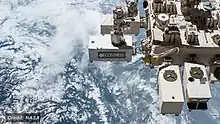ECOSTRESS
ECOSTRESS (Ecosystem Spaceborne Thermal Radiometer Experiment on Space Station) is an ongoing scientific experiment in which a radiometer mounted on the International Space Station measures the temperature of plants growing in specific locations on Earth over the course of a solar year. These measurements give scientists insight into the effects of events like heat waves and droughts on crops.[1]

The instrument that collects this data is a multispectral thermal infrared radiometer. It measures temperatures on the surface of the earth, rather than surface air temperature.[2][3] Dr. Simon Hook is the Principal Investigator of the ECOSTRESS mission and Dr. Joshua Fisher is the Science Lead; both are located at NASA's Jet Propulsion Laboratory (JPL).[3] ECOSTRESS data are archived at the Land Processes Distributed Active Archive Center (LP DAAC), which is a data center managed by the U.S. Geological Survey. ECOSTRESS data are discoverable through various platforms including through LP DAAC's AppEEARS tool, which allows users to quickly subset and reproject data into a geographic lat/lot format. The data collected is also published via the open-access TERN Data Discovery Portal in Australia.[3]
The ECOSTRESS radiometer was built at JPL and consisted of 5 spectral bands in the thermal infrared (8-12 micron) and 1 band in the shortwave infrared, which is used for geolocation . ECOSTRESS was delivered to the ISS by the SpaceX Dragon after a launch out of Cape Canaveral, FL on June 29, 2018[4] The Dragon arrived at the space station on July 3, 2018.[4] The radiometer was mounted on the station's Kibo module. The radiometer constituted about 1,213 pounds (550 kg) of the 5,900 pounds (2,700 kg) of cargo on board the Dragon.[5] Other cargo included spare parts for the Canadarm2 robotic arm, as well as other equipment and supplies.[1]
The key science questions that ECOSTRESS is addressing include (1) How is the terrestrial biosphere responding to changes in water availability? (2) How do changes in diurnal vegetation water stress impact the global carbon cycle? and (3) Can agricultural vulnerability be reduced through advanced monitoring of agricultural water consumptive use and improved drought estimation?
The original ECOSTRESS Science Team included Dr. Glynn Hulley (JPL) and scientists at the U.S. Department of Agriculture, including Dr. Andrew French and Dr. Martha Anderson. Other science team members include Drs. Eric Wood (Princeton), Rick Allen (University of Idaho), and Chris Hain (NASA Marshall Space Flight Center). ECOSTRESS is the first Earth Venture mission to establish an Early Adopters Program, which provided its members with early access to provisional data and opportunities to collaborate with other ECOSTRESS users in a Slack channel. As of August 2019, the Early Adopters Program has transitioned to the ECOSTRESS Community of Practice, with over 250 members.
Science data products produced by ECOSTRESS include:
| Data Product | Description | Pixel Size* | Temporal
Resolution (days) |
|---|---|---|---|
| ECO1BRAD.001 | Radiance | 70 x 70 | Over continental United
States and target areas**, every 1-7 days |
| ECO1BATT.001 | Attitude and Ephemeris | ||
| ECO1BMAPRAD.001 | Projected Radiance | ||
| ECO1BGEO.001 | Geolocation | ||
| ECO2LSTE.001 | Land Surface Temperature and Emissivity | ||
| ECO2CLD.001 | Cloud mask | ||
| ECO3ETPTJPL.001 | Evapotranspiration (PT-JPL model enhanced) | ||
| ECO3ANCQA.001 | Ancillary Data Quality | ||
| ECO3ETALEXIU.001 | Evapotranspiration (ALEXI model enhanced) | 30 x 30*** | |
| ECO4ESIPTJPL.001 | Evaporative Stress Index derived from L3_ET_PT-JPL | 70 x 70 | |
| ECO4ESIALEXIU.001 | Evaporative Stress Index derived from L3_ET_ALEXI | 30 x 30*** | |
| ECO4WUE.001 | Water Use Efficiency | 70 x 70 | |
| *More accurately referred to as pixel spacing resolution (m) because of dependencies on ISS altitude, which varies.
**For more info, please visit ECOSTRESS Gmap to see where data has been acquired ***70 x 70 is resampled to 30 x 30 (meters) | |||
See also
References
- Clark, Stephen (June 28, 2018). "Commercial SpaceX cargo capsule readied for launch Friday". Spaceflight Now. Pole Star Publications. Retrieved 2018-10-02.
- "ECOSTRESS Maps LA's Hot Spots". ecostress.jpl.nasa.gov. Jet Propulsion Laboratory. September 18, 2018.
- "UQ center's data used in space station study of global climate" (Press release). University of Queensland. Retrieved 2018-10-02 – via EurekAlert!.
- "ECOSTRESS Launches to Space Station on SpaceX Mission". NASA/JPL. Retrieved 2019-08-13.
- "ECOSTRESS launches to space station on SpaceX mission" (Press release). Jet Propulsion Laboratory. Retrieved 2018-10-02 – via Phys.org.
